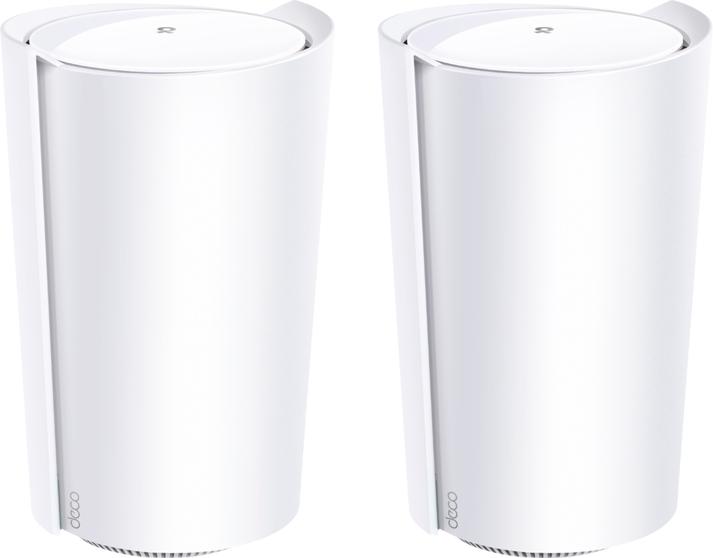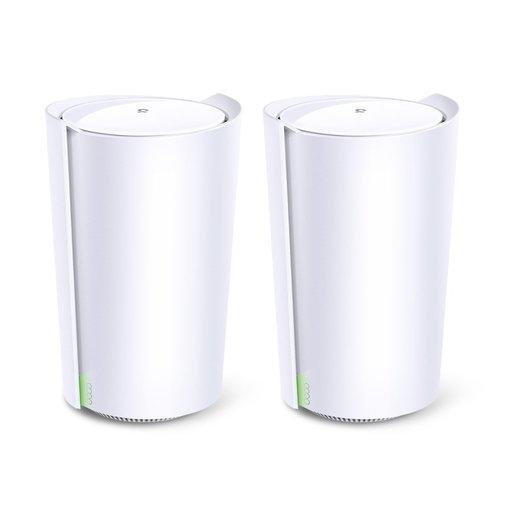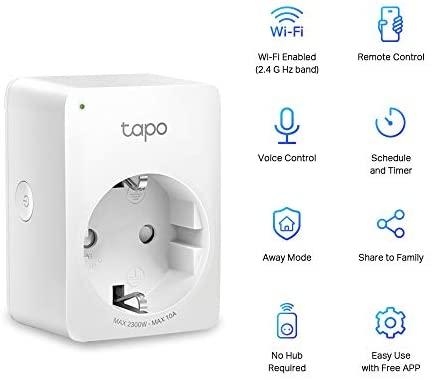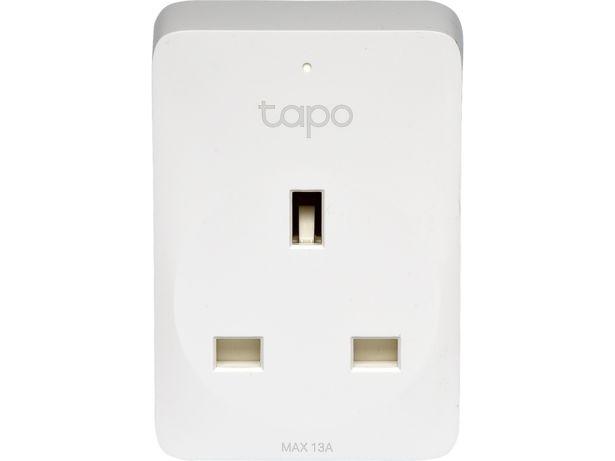TP-Link Deco X90 AX6600 Whole Home Mesh Wi-Fi System
TP-Link’s Deco X90 ($499.99) is a pricey two-piece mesh system designed to bring Wi-Fi 6 networking to all corners of your house. A tri-band AX6600 system, it offers multi-gig Ethernet, robust parental controls, and network security software, although some of these features require a HomeShield Pro subscription. The X90 is simple to install and delivered fast throughput speeds in our tests, but our Editors' Choice winner, the $449.99 Asus ZenWiFi AX (XT8), is slightly faster, covers a similar amount of space, and offers free lifetime network protection.
Stylish Cylinders
The Deco X90 consists of two identical cylinder-shaped nodes that combine to provide up to 6,000 square feet of coverage (just a bit more than the XT8's 5,500 square feet). They stand 8.3 inches high, are 5.1 inches wide, and sport a matte white finish. Each node is equipped with two auto-sensing Ethernet ports, one of which is a 2.5GbE port (the other is a 1GbE port), but as is the case with most mesh systems, USB ports are nowhere to be found. An LED indicator on the front of each node glows solid yellow during startup, solid blue during setup, and solid green when all is working as it should. A blinking red LED indicates that a node has been disconnected from the main router, while a solid red LED indicates a network issue.
Inside each node are six internal antennas, a 1.5GHz quad-core CPU, 802.11k/v/r mesh circuitry, and 802.11ax circuitry. The X90 supports all of the latest Wi-Fi 6 technologies including MU-MIMO simultaneous data streaming, OFDMA packet transmissions, direct-to-client beamforming, Smart Connect automatic band steering, WPA3 encryption, and 160MHz channel bandwidth. This is a tri-band AX6600 system that can reach maximum data rates of up to 574Mbps on the 2.4GHz band, 1,201Mbps on the one 5GHz band, and 4,804Mbps on the other 5GHz band. You can use the Ethernet ports for wired backhaul, or let one of the 5GHz bands handle it.
The X90 comes with TP-Link’s HomeShield Basic security software, which offers rich parental controls with age-based web filters, website blocking, and bedtime shutdown scheduling. However, you’ll have to subscribe to the $5.99 per month/$54.99 per year HomeShield Pro plan to access premium features such as Time Limits, Time Rewards, and Traffic Statistic reports. The Pro plan also gets you protection against virus attacks, phishing schemes, and other malware, as well as real-time protection for all of your smart home devices. That's less than you'll pay for a HomePass subscription required to use the Plume SuperPod With Wi-Fi 6 ($99 for one year, $179 for two years, or $249 for three years), but more than the Asus ZenWiFi AX XT8, which offers free lifetime network protection.
As with the Deco X20 and other TP-Link mesh systems, the X90 can be managed from your Android or iOS phone using the TP-Link Deco mobile app. There’s also a web-based console available, but the app is more intuitive and offers more settings. It opens to an Overview screen that shows the name of your network, online clients, and offline clients. Tap any client to see real-time upload and download speeds and to give that client high-bandwidth priority. Tap the gear icon in the upper right corner to view the client’s IP and MAC addresses, see which band it's connected to, and disable seamless roaming (Mesh Technology).

At the bottom of the screen are Overview, Smart Actions, HomeShield, and More buttons. The Overview button takes you back to the main screen from wherever you are in the app, while the Smart Actions button is where you go to create automations between TP-Link Kasa smart devices such as smart plugs and lights that are connected to the network. The HomeShield button takes you to a screen where you can scan for network security issues and optimize the network, enable malware protection, create user profiles for family members, assign bandwidth priority to client devices, and view network activity reports. The More button opens a Router Settings screen where you can configure Wi-Fi settings, create blacklists to prevent clients access to the internet, optimize the network, update firmware, and add users to help you manage the network. Advanced settings include IPv4 and IPv6 settings, DHCP Server settings, and Port Forwarding, Beamforming, and Fast Roaming settings.
TP-Link Deco X90 Installation and Performance
The X90 was easy to install thanks to the intuitive Deco mobile app. After downloading the app, I tapped Let’s Begin and selected the X90 from the list of systems. Following the on-screen instructions, I powered off my modem and using the included LAN cable connected an X90 node to it to act as my router node. I powered up the modem and the X90 node, tapped Next, and verified that the router node’s LED was pulsing blue. I then used my phone’s Wi-Fi settings to connect to the router, returned to the app, and gave the router a name. After verifying the internet connection type (Dynamic), I gave the new network a name and password and tapped Connect. Once the network was up and running, I tapped Next and followed the instructions to plug in the satellite node. After 30 seconds or so it was automatically added to the network, and after a quick firmware update the installation was finished.
The X90 turned in impressive results on our throughput performance tests. The main router’s speeds of 888Mbps on our close-proximity (same room) test was one of the highest we’ve seen from a mesh system, if only by a small margin. It squeaked past the Asus ZenWiFi AX XT8 (860Mbps), the Linksys Velop AX MX106000 (865Mbps), and the Netgear Orbi AX6000 RBK852 (862Mbps). However, the X90's speed of 305Mbps on the 30-foot test was a bit slower than the competition. The Asus ZenWiFi AX XT8 led with a speed of 347Mbps, while the Linkys Velop AX6000 scored 333Mbps and the Netgear Orbi AX6000 RBK852 managed 324Mbps.
See How We Test Wireless RoutersSee How We Test Wireless Routers
The X90 satellite node turned in a respectable 623Mbps on the close-proximity test, coming in just behind the Netgear Orbi AX6000 RBK852 (639Mbps). The Linksys Velop AX6000 garnered 667Mbps, while the Asus ZenWiFi AX XT8 led with 675Mbps. The X90’s 30-foot speed of 583Mbps beat the Netgear Orbi AX6000 RBK852 (550Mbps), but not the Linksys Velop AX6000 (611Mbps). Once again, the Asus ZenWiFi AX XT8 took top honors with a speed of 619Mbps.
We use an Ekahau Sidekick Wi-Fi diagnostic device and Ekahau’s Survey mobile app to test wireless signal strength (Editors' Note: Ekahau is owned by Ziff Davis, PCMag's parent company.) This combination generates a heat map that illustrates coverage throughout our test home.
On the map, darker green areas indicate the strongest signal measurements, and lighter green and yellow areas show a weaker signal. The circles represent the location of the router and the satellite node. As shown on the map, the X90 system did a relatively good job of delivering a strong Wi-Fi signal throughout most of our test home. The signal weakened in parts of the lower left bedroom, but we’ve seen this with other mesh systems as there are several walls between the node and this area of the house.
A Strong Option for Whole-Home Wi-Fi 6
The TP-Link Deco X90 mesh system is solid choice if you're looking to blanket a large home in Wi-Fi 6. It’s easy to set up and manage using the intuitive Deco mobile app, and it delivered strong throughput in testing. We like that it offers multi-gig connectivity and comes with rich parental controls, but wish that the subscription-based HomeShield features were included in the price of the system. A USB port or two would also be welcome. For around $50 less, the Asus ZenWiFi AX XT8 offers better overall performance and is equipped with a USB 3.1 port. It also comes with a lifetime subscription to Asus’ AIProtection Pro suite of anti-malware and parental control tools. As such, it remains our Editors’ Choice winner for Wi-Fi 6 mesh systems.



